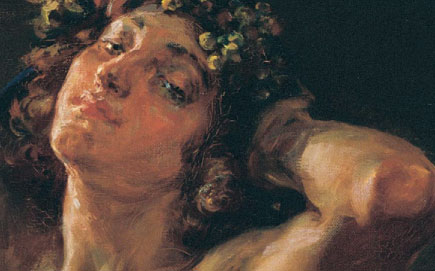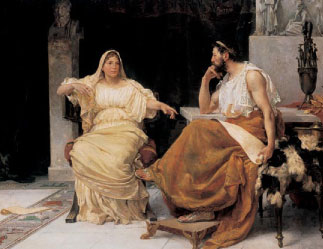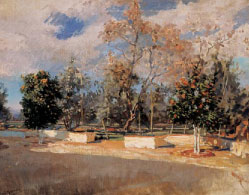

JOSÉ GARNELO Y ALDA A Painter between two Centuries |

José Garnelo y Alda (1866 – 1944) was a key figure in painting at a stage of profound changes at all levels, which turned out to be determining factors in the promotion of new approaches in the plastic arts, and which eventually facilitated the adoption of the concept of the avant-garde. Educated in the development of what came to be called Painting of History, José Garnelo adopted a receptive and, at the same time, reflective attitude towards the new artistic approaches, which inspired important innovations in the world of art. He tried to combine in a masterly synthesis those values which in his judgment should be considered essential, taken from what was ancient, with other necessary revitalizing approaches, which for him constituted the essence of what was new. His unfailing commitment resulted in his fertile and untiring labour as a trainer of successive generations of artists, who developed further many of the theoretical and practical approaches which he himself inculcated in them, and which led his disciples - as happened in the case of Picasso – to be the basis of the most fruitful and important pages of contemporary painting. Nevertheless, Garnelo always bore in mind his humanist duty, and as he himself wrote, “nature will always be the mother of all artistic expression; she, who surrounds us and to whom we belong, is what brings to the wealth of the artist the elements of truth, emotion and harmony, the three main attributes of beauty, the supreme goal of art.”
He taught in the best Fine Arts institutions in Spain; he knew personally the most distinguished avant-garde authors of his generation, a fact which kept him up-to-date with the latest artistic developments; he travelled tirelessly around Europe, visiting its most beautiful cities, studying closely the contents of its most famous museums; with his fresh pedagogic approaches he reformed artistic teaching, encouraging the study of the figure in motion and the practice of drawing from memory, to the detriment of conventional methods based on mimetic practises, as applied to classical sculpture.
He was a cosmopolitan painter, untiring traveller, active academic, enthusiastic educator from his professorship at the San Fernando Institute of Fine Arts; a writer profoundly committed to the defence of the artistic heritage; one who spread historic-artistic ideas and promoted incipient editorial projects focussing on the world of art; a tireless reader, whose comprehensive training granted him a range of vision rare among the artists of his generation.
 Among his many awards stand out two First Prizes, obtained at the “National Exhibitions of Fine Art” in 1892 and 1901, two Second Prizes, granted at the calls of 1887 and 1890, the Gold Medal at the Universal Exhibition of Chicago in 1893, and the Honourable Mention achieved at the Salon de Paris in 1896. He was awarded a pension by the Spanish Academy of Fine Arts in Rome; he was a Select Academic of the Royal Academy of Fine Arts in San Fernando, assistant director of the Prado Museum and Crown Painter. He was also decorated with the appointments of Official of the Order of Leopold II of Belgium, Knight Commander of the Order of Alfonso XII, Knight of the Order of Carlos III and of the French Légion d’Honor.
Among his many awards stand out two First Prizes, obtained at the “National Exhibitions of Fine Art” in 1892 and 1901, two Second Prizes, granted at the calls of 1887 and 1890, the Gold Medal at the Universal Exhibition of Chicago in 1893, and the Honourable Mention achieved at the Salon de Paris in 1896. He was awarded a pension by the Spanish Academy of Fine Arts in Rome; he was a Select Academic of the Royal Academy of Fine Arts in San Fernando, assistant director of the Prado Museum and Crown Painter. He was also decorated with the appointments of Official of the Order of Leopold II of Belgium, Knight Commander of the Order of Alfonso XII, Knight of the Order of Carlos III and of the French Légion d’Honor.
His body of work, celebrated and prized in national and foreign exhibitions, can be admired in museums and institutions in Europe and America, as examples of the honesty he was able to bring to his work, of the coherence achieved in his own artistic expression, and of the acclaimed prestige of his output.
 One of the most gratifying corollaries for the life of an artist is for a large part of his output to be collected in a single exhibition space with the constitution of a museum, and this is also the best way of getting to know a body of work previously scattered or included in private and inaccessible collections, where little or nothing was done to preserve the memory of this great artist. The Garnelo Museumwas officially inaugurated on the 18th of December 2000, with the generous support of private collectors and heirs of the “maestro”, as a result of a joint effort by private initiative and public institutions. Its creation is due to the town of Montilla, through its local Council, as public acknowledgment of admiration for the “Montillian” by upbringing, adoption and vocation that was José Garnelo, who has at last seen his privileged place in the History of Art recognized in this place which he loved so much – and where his remains rest, by his wish. In this magnificent environment of the House of the Waters,the viewer has a unique opportunity to contemplate the complete spectrum of the various artistic phases of the painter, including a good selection of some of his most outstanding master-works. In the different rooms which make up the museum, his different aspects are well represented: the painting of history, mythology, the religious facet, his thoughtful sketches in preparation for those difficult murals; works with an animalist theme, landscapes, genre and local customs painting, portraits… even his most intimate works, displayed through his innovative, creative ideas drawn from the resources of his memory, or using his notes taken directly from life.
One of the most gratifying corollaries for the life of an artist is for a large part of his output to be collected in a single exhibition space with the constitution of a museum, and this is also the best way of getting to know a body of work previously scattered or included in private and inaccessible collections, where little or nothing was done to preserve the memory of this great artist. The Garnelo Museumwas officially inaugurated on the 18th of December 2000, with the generous support of private collectors and heirs of the “maestro”, as a result of a joint effort by private initiative and public institutions. Its creation is due to the town of Montilla, through its local Council, as public acknowledgment of admiration for the “Montillian” by upbringing, adoption and vocation that was José Garnelo, who has at last seen his privileged place in the History of Art recognized in this place which he loved so much – and where his remains rest, by his wish. In this magnificent environment of the House of the Waters,the viewer has a unique opportunity to contemplate the complete spectrum of the various artistic phases of the painter, including a good selection of some of his most outstanding master-works. In the different rooms which make up the museum, his different aspects are well represented: the painting of history, mythology, the religious facet, his thoughtful sketches in preparation for those difficult murals; works with an animalist theme, landscapes, genre and local customs painting, portraits… even his most intimate works, displayed through his innovative, creative ideas drawn from the resources of his memory, or using his notes taken directly from life.
Surely now, the visitor will be able to appreciate fully a life of work and dedication to the arts, as manifested in this museum dedicated to the memory of the artist.
M. C. L.